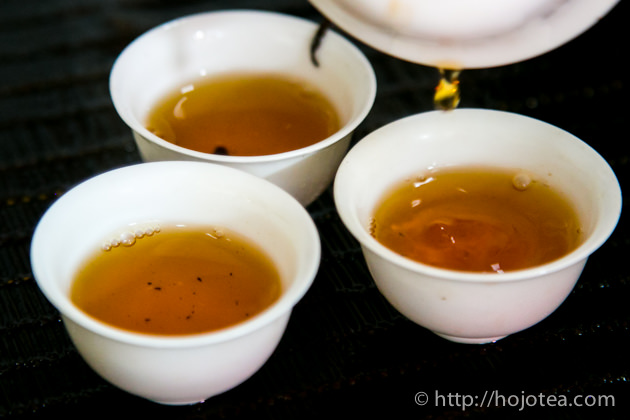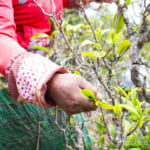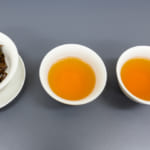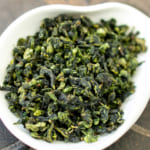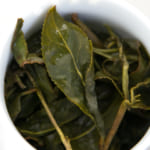- HOME >
- Tea Processing
Making 4 times fired Phoenix Oolong Lao Cong Shui Xian

We just placed an order for very unique types of Phoenix Lao Cong Shui Xian. It is the Shui Xian collected from old tea tree, and undergoing four times baking. The entire baking process takes one year for production. I am only able to receive this tea in next year.
It is the baking that composes the unique characteristic of Phoenix oolong
The key process in making Phoenix Dan Cong oolong is baking the tea at lower temperature for a long time. Some people might associate the word “baking” to “burnt” or “roast”. For making Phoenix oolong, it is totally different concept.
The objective of baking is not to burn tea but to cause maturation and bring out the fruity flavor of tea. The skilled tea master manages the temperature below 100 degree C, and in order to produce tea with the ideal fruity flavor, the baking has to be conducted for a very long time. One may think that to set the temperature is just set the temperature once, and it’s so easy. This is only applicable if it refers to electric oven with control panel. In making Phoenix oolong, the ultimate Phoenix oolong comes from the baking with charcoal fire.
It is so hard to manage the consistent temperature with charcoal fire. As a result, a number of manufacturers intentionally or may be unintentionally use temperature above 100 degree, or they will choose to use the electric oven for baking. The electric oven does bring up quite nice flavor. But in term of tea taste, it is incomparable with outcome of the charcoal fire. The taste of tea baked with charcoal fire is very clear and long lasting.
Our Phoenix tea lineups are all baked using charcoal fire.
The above photo shows single fired Phoenix tea
Double fired Phoenix Oolong
Depending on the preference of the market and customers, the manufacturer will adjust the extent of baking. We usually select each type of Phoenix tea and we will decide the baking extent based on the market’s need and the characteristic of tea.
The Phoenix tea baked at shorter period of time is called Qing Xiang (in Chinese it means refreshing flavor). It gives floral and uplifting flavor. We also have the lineup called Double-fired. It is called Nong Xiang (in Chinese means Thick flavor).
Some people might think that the double-fired tea is heavily fired, and so tea has a scorched flavor or charcoal-like flavor. The fact is that the well-made double fired (Nong Xiang) Phoenix tea is supposed to give no burnt flavor, but it has strikingly thick fruity flavor like stone fruit, with a clear and sweetish drinking sensation on palate. In order to achieve this flavor and taste profile, it is essential to bake tea below 100 degree Celsius for long hours. It requires intensive care and attention during the long baking hours and the tea master has to closely monitor the temperature continuously. The well-managed baking process brings upon a clear fruity flavor without a hint of burnt or charcoal note, even after tea is baked for 24 hours.
Double Fired Phoenix Oolong
4 times fired Shu Xian loved by the people in Shantou city
There are two big cities located nearby the production area of Phoenix tea. They are Chaozhou and Shantou city. Generally, Chaozhou people prefer the thick-fruity flavor with double fired, while in Shantou traditionally people prefer three to four times fired tea.
To bake tea for four times, the tea manufacturer is unable to complete it continuously as the moisture content in tea is going to be too low. The tea will be baked once, and then it is kept away to rest for about three months before the next baking in order to let the tea reabsorb the moisture.
We placed the special order for the four times fired Shui Xian
Generally, the four times fired Shui Xian processed for Shantou market not very high grade. The high-end Shui Xian such as Lao Cong Shui Xian is fired one or two times and it is sold in Chaozhou city. Even if it is not the high grade Shui Xian, I was so impressed by its unique drinking sensation and the distinctive characteristic in flavor. It gives very mellow mouth feel like vintage oolong, with bold and thick-matured dried fruity note filled up our palate and its lingering sweetness lasts for a long time. When I tasted, I thought I did not mind buying it even if it was of lower grade. However, the lower grade Phoenix oolong is often collected from the garden that is located at the lower altitude. As a trend, the pesticide is often detected in the tea collected from lower altitude. I was also curious to experience how the flavor of high-grade Shui Xian will be if it is fired 4 times. I selected the Lao Cong Shui Xian mao-cha and placed a special order to bake it four times, which the whole baking process will takes a year to complete. This tea will only be ready when we visit them again in next year.
In near future, I am also wishing to run the baking experiment using Mi Lan Xiang. Out of my curiosity I am eager to find out how the flavor will be when this tea is baked three or four times.
Related Articles
How to get the latest update on HOJO Tea?
1. Follow Twitter, 2. Click "Like" on Facebook, and 3. Subscribe in newsletter. You can have the latest tea news from HOJO Tea.
 Subscribe the Newsletter to enjoy the privileges
Subscribe the Newsletter to enjoy the privileges- You may receive a free sample upon purchase, or you may have the priority to purchase special products. So please remember to subscribe our newsletter as well as the social network.
- New Release of Wild Pu-erh Jasmine Pearl
- Out of curiosity, we decided to create a jasmine tea based on Da Xue Shan Wild Raw Tea. This resulted in an exceptionally rare tea, not only in Japan but also in China. Custom Production Network for Jasmine Tea At our store, we source various types of base teas from different regions during the spring. …
- New Release of Anxi Traditional Oolong
- Anxi, located in Fujian province, China, is celebrated for its Tie Guan Yin tea. However, the Traditional Anxi Oolong from this region boasts a unique fruity aroma, distinguishing it from Tie Guan Yin. Anxi: A Renowned Hub for Oolong Tea Production in China Fujian Province, renowned for its rich tea heritage, boasts several prominent tea-producing …
NEW ARTICLES
 New Release of Wild Pu-erh Jasmine Pearl
New Release of Wild Pu-erh Jasmine Pearl- Out of curiosity, we decided to create a jasmine tea based on Da Xue Shan Wild Raw Tea. This resulted in an exceptionally rare tea, not only in Japan but also in China. Custom Production Network for Jasmine Tea At our store, we source various types of base teas from different regions during the spring. …
 2024 Overview: Our Yunnan White Tea Quality, Process, and Weather Insights
2024 Overview: Our Yunnan White Tea Quality, Process, and Weather Insights- One of the teas we’ve been focusing on in Yunnan Province is white tea. Historically white tea has been produced in both Fujian Province and Yunnan Province for a long time. While white tea from Fujian Province is well-managed during processing, we are dissatisfied with the quality of the raw materials due to the use …
 Yunnan’s Hospitality Culture: Expressed Through Meals
Yunnan’s Hospitality Culture: Expressed Through Meals- In China, as a form of greeting, it’s common to say “你吃饭了吗?” which means “Have you eaten?” However, in Yunnan Province, the phrase “吃饭” is often used in various situations, more like “Eat, eat,” serving as an invitation to share a meal. Yet, with prolonged exposure to Yunnan, one comes to understand that these meal …
 In Search of Wild Tea: Exploring Mountain Villages in Southwest Lincang, Yunnan
In Search of Wild Tea: Exploring Mountain Villages in Southwest Lincang, Yunnan- We are currently sourcing tea in the southwestern part of Lincang City, Yunnan Province. One of the crucial products for us is wild tea. While tea processing is important, securing the raw materials poses the biggest challenge. Recently, we received information about a new location where wild tea supposedly grows. To verify this, we visited …
 New Release of Anxi Traditional Oolong
New Release of Anxi Traditional Oolong- Anxi, located in Fujian province, China, is celebrated for its Tie Guan Yin tea. However, the Traditional Anxi Oolong from this region boasts a unique fruity aroma, distinguishing it from Tie Guan Yin. Anxi: A Renowned Hub for Oolong Tea Production in China Fujian Province, renowned for its rich tea heritage, boasts several prominent tea-producing …
 Yunnan 2024 Spring Tea Sourcing
Yunnan 2024 Spring Tea Sourcing- Yunnan Province is globally renowned for the exceptional quality of its tea leaves. However, lax production management often presents challenges in achieving the desired tea quality when relying solely on pre-made teas. To address this issue, we have committed to remaining on-site throughout the spring season to closely monitor tea production. We are meticulously inspecting …
 The Relationship Between Greenness of Tea Leaves and Fertilizer
The Relationship Between Greenness of Tea Leaves and Fertilizer- For both tea and vegetables, there’s a common misconception that a deeper green colour indicates better quality and greater health benefits. However, this isn’t always the case. Natural plants often have a yellowish-green hue rather than a vibrant green. If you observe wild plants in grasslands or along roadsides during spring, you’ll notice that they …
 Creating Muscatel Black Tea Using a Unique Blending Method
Creating Muscatel Black Tea Using a Unique Blending Method- I would like to introduce the unique creation of black tea with a distinctive muscatel flavor profile. Acquiring Exceptional Mi Xiang Black Tea Have you ever heard of a unique black tea called “Mi Xiang Black Tea” or “Muscatel Black Tea”? This tea is crafted from leaves that have been delicately nibbled by leafhoppers, resulting …
 New Release of Lan Yun Tie Guan Yin from Anxi
New Release of Lan Yun Tie Guan Yin from Anxi- Lan Yun Tie Guan Yin from Anxi, is not just an ordinary Tie Guan Yin. It has a strikingly delightful flavor reminiscent of orchid flowers with silky-soft drinking sensation. Anxi, renowned as one of the three major Oolong tea production regions in China. Anxi is recognized as one of the three major Oolong tea-producing regions …
 The Difference Between Fermentation in Tea and Fermented Foods
The Difference Between Fermentation in Tea and Fermented Foods- Black tea and oolong tea are often categorized as “fermented teas,” but the extent to which they undergo fermentation raises questions about whether they truly qualify as fermented foods. In this article, I endeavour to offer a thorough exploration of the distinctions between tea and traditional fermented foods, shedding light on the nuances of their …
Shop Info

Address:Lot No. T-215, 3rd Floor, The Gardens Mall, Mid Valley City, Lingkaran Syed Putra, 59200 Kuala Lumpur
Tel: +603-2287-4537
Business Hour: 10am to 10pm
Category
- New Arrival at HOJO Online Shop
- Featured Articles
- Newsletter
- Types of Tea
- Origin of Tea
- Teapot and Tea Equipment
- Tea Column
- How to enjoy tea
- Tea Processing
- How to choose quality tea
- Tea constituents and functional effect
- Safety of Tea
- Foods
- Tea Business Operation
- Hobby and Outdoor Activity
- Ranking of Tea
- Video
- FAQ
- Media Release
Profile

- AKIRA HOJO
- I invite you to experience my tea selections.I was born in Nagano, Japan. In university, I studied agricultural chemistry, and I have the master degree in food science. I worked in Japanese food industry for 10 years. I involved in R&D, QC and QA. As a factory manager, I implemented ISO9000 series and managed the factory.
- The Art of Tea Magazine
- We posted the article on “The Art of Tea Magazine No.9, the magazine is published in Taiwan. We featured some scientific view about the tetsubin
- New Straits Times
- The Malaysian National Newspaper, New Straits Times featured HOJO Tea on 17-Oct-2007.




